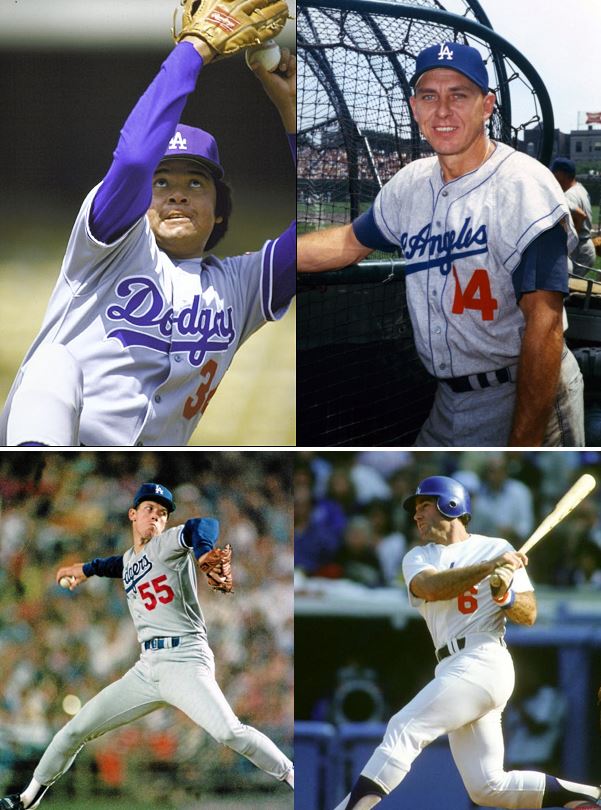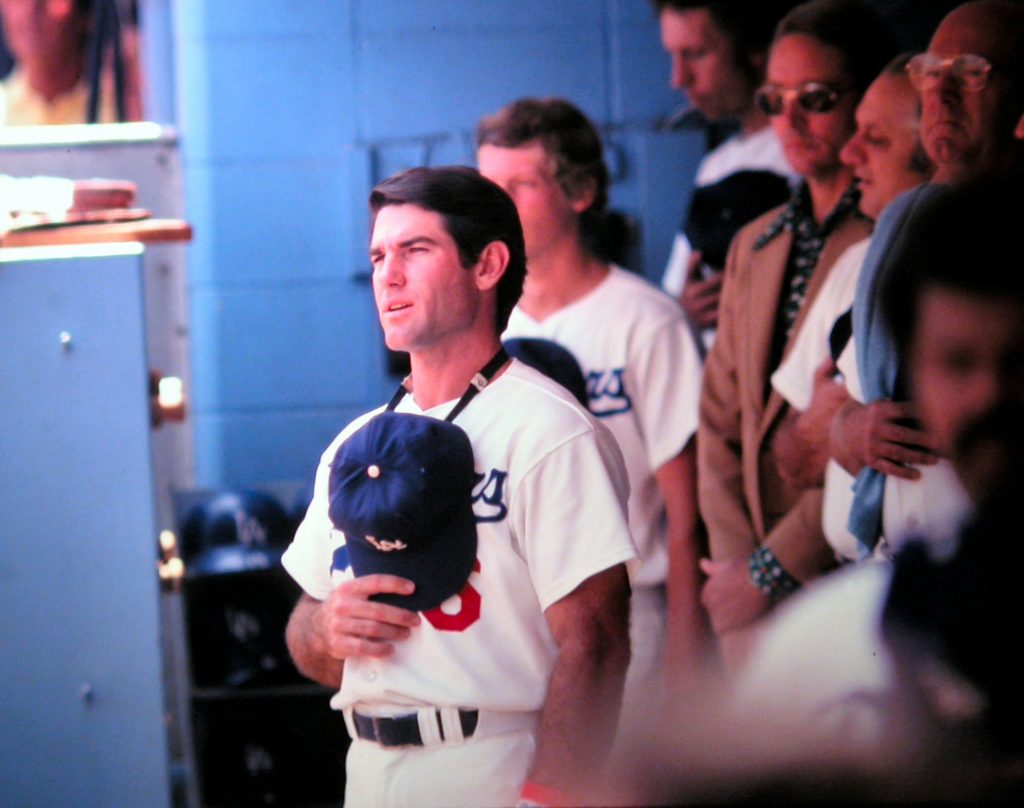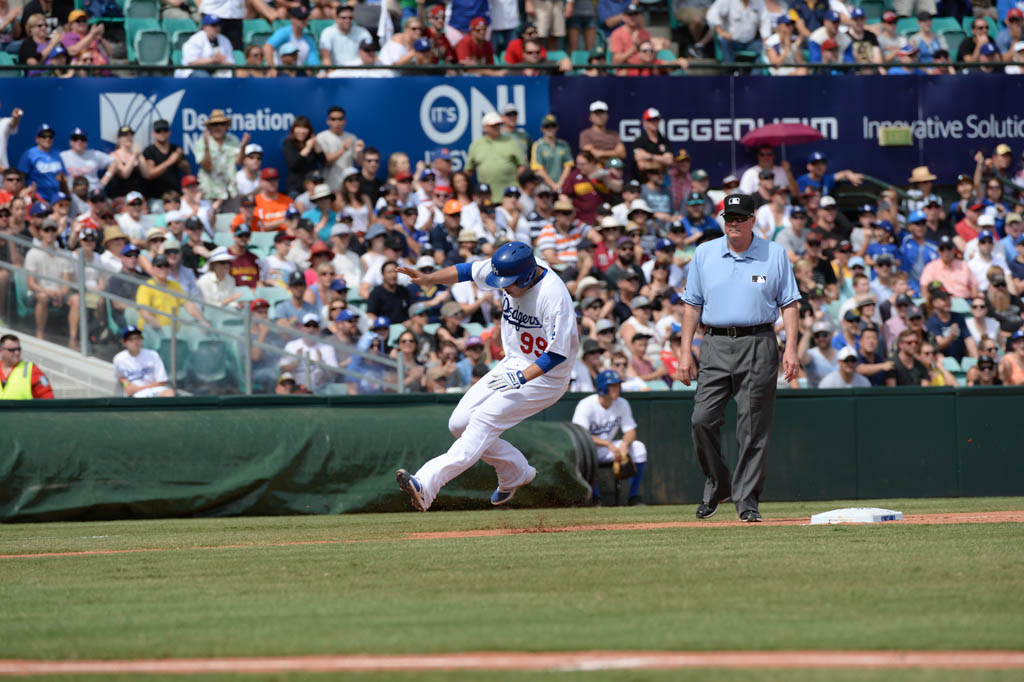So now Fernando Valenzuela has to get in. So now Gil Hodges has to get in. So now Orel Hershiser has to get in. So now Steve Garvey has to get in. So now …
Tag: Reggie Smith
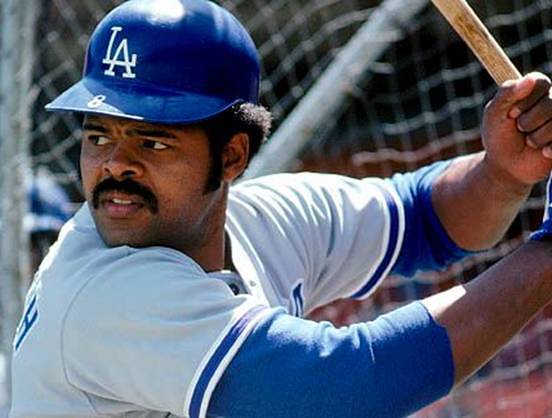
The Hall of Nearly Great, a collection of essays about memorable major-league players who weren’t considered worth of the Hall of Fame, came out in 2012. I contributed the following chapter about Reggie Smith.
As an adult, maybe even as a teenager, you see the complete arc of a major-leaguer’s career. You’re there for the beginning – or, depending on your level of dedication, the pre-beginning: the minors, the run-up to the draft, college or high-school ball.
But when you’re a kid, you encounter ballplayers in media res. They arrive in your consciousness fully formed. Past is the opposite of prologue – past is epilogue.
Reggie Smith landed in my world in the middle of the 1976 season, the first full season that, at age 8, I became invested in the Los Angeles Dodgers as a fan. Speaking of fully formed: He joined a team that had that infield: Steve Garvey at first base, Davey Lopes at second, Bill Russell at short, Ron Cey at third. These were the people in our neighborhood.
Smith dropped in out of nowhere, by way of St. Louis. What was supposed to happen? It couldn’t have been that he would become the favorite player in the lineup for a kid fan birthed on Garvey, Lopes, Russell and Cey. That he would be the gateway to a life of challenging the conventional wisdom of who was most valuable.
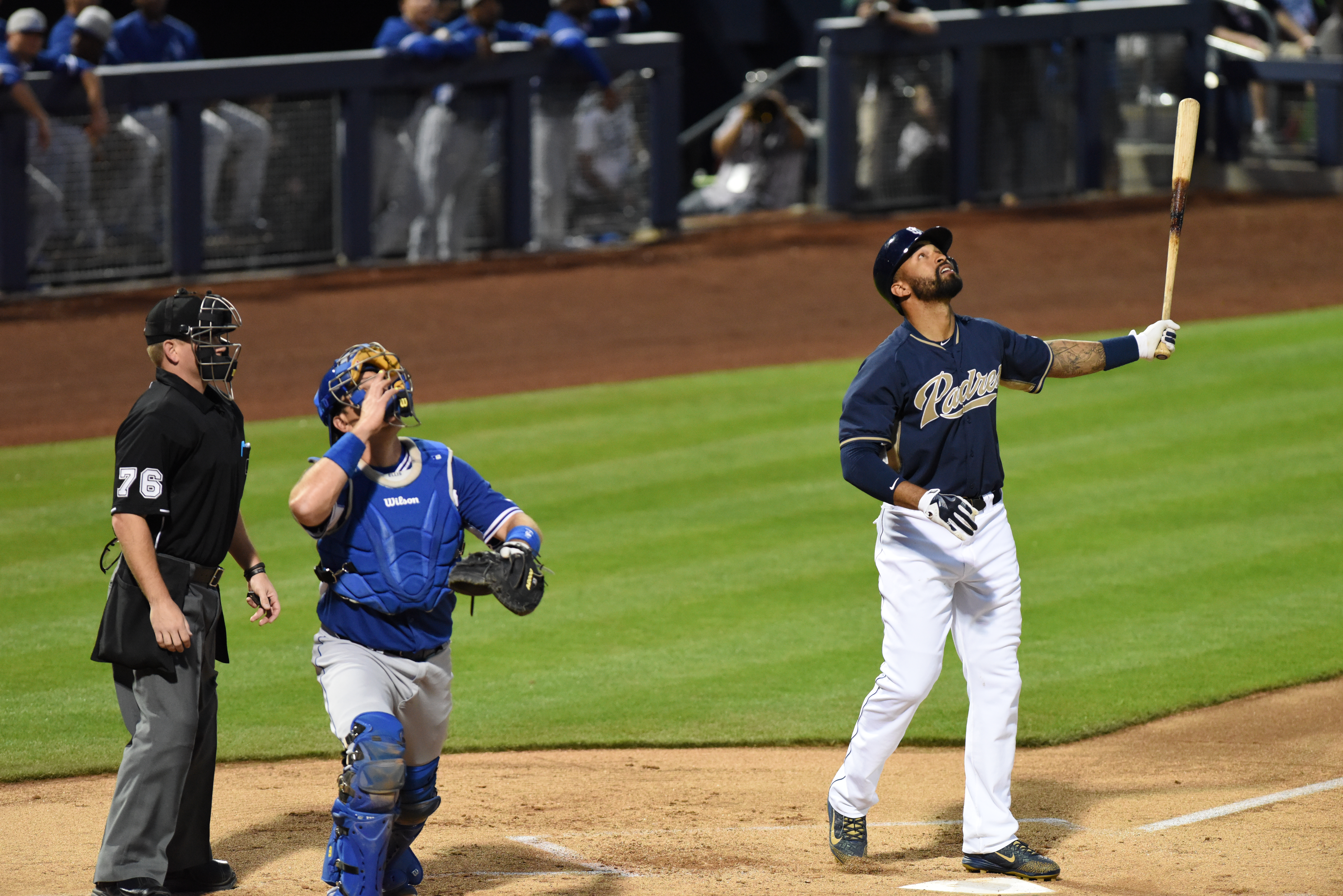
Matt Kemp first faced the Dodgers in a March 12 exhibition game. A week from today, it counts. (Jon SooHoo/Los Angeles Dodgers)
For photos from Sunday, visit LA Photog Blog.
Jimmy Rollins, SS
Yasiel Puig, RF
Adrian Gonzalez, 1B
Howie Kendrick, 2B
Carl Crawford, LF
Juan Uribe, 3B
Joc Pederson, CF
A.J. Ellis, C
Brett Anderson, P
By Jon Weisman
If you’re like Vin Scully, and you think it’s going to be weird to see Matt Kemp suit up for the Padres against the Dodgers on Opening Day in his first official career game for another team, you’re right.
Nothing like it has ever happened.
In the history of Dodger Stadium Opening Days, no other former Dodger — let alone one of Kemp’s current magnitude — has made his debut for an opponent before Scully and friends.
There have been a few former Dodgers to play for the opposition at Dodger Stadium on Opening Day, most recently Dave Roberts for the Giants in 2008 and Ismael Valdez for the Padres in 2004, but not very many, and they were always years removed from their last appearance in Dodger blue. (If you want to include road openers, former Dodger knuckleballer Charlie Hough pitched the Marlins’ first MLB game ever, against the Dodgers in 1993.)
Steve Garvey — the biggest name to go directly from Los Angeles to San Diego before Kemp — was at first base for the Padres at Dodger Stadium on Opening Day 1986, but Garvey was already in his fourth season with San Diego.
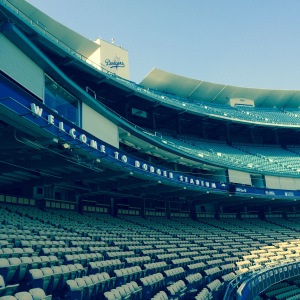 The highest-profile Dodger ever to play his next game for an opponent on Opening Day at Dodger Stadium was Reggie Smith, who started at first base for the Giants on April 6, 1982 — Los Angeles’ first official game since winning the World Series. Even this couldn’t be considered a big a deal as Kemp. Though revered by this author, Smith was not a career Dodger, and he had already ceased to be an integral part of the team by 1981, collecting seven hits and seven walks the entire year.
The highest-profile Dodger ever to play his next game for an opponent on Opening Day at Dodger Stadium was Reggie Smith, who started at first base for the Giants on April 6, 1982 — Los Angeles’ first official game since winning the World Series. Even this couldn’t be considered a big a deal as Kemp. Though revered by this author, Smith was not a career Dodger, and he had already ceased to be an integral part of the team by 1981, collecting seven hits and seven walks the entire year.
To find a Dodger regular who played an Opening Day for an opponent in Los Angeles the very next year, you have to go all the way back to a different venue and the very first Game No. 1 played in Los Angeles: April 12, 1960. (The Dodgers opened on the road for their first two seasons after moving from Brooklyn.) That player was Don Zimmer, who had been pushed to the bench by shortstop Maury Wills midway through the 1959 season.
That’s not to say there wasn’t some shock for local fans: Zimmer was traded to the Cubs on April 8, only four days before the start of the season, which found him at third base for Chicago at the Los Angeles Memorial Coliseum.
Still, Don Zimmer playing for the Cubs at a Dodger home opener is nothing compared with what it’s going to be like to see Matt Kemp playing right field for the Padres a week from today. Surreal is a word that comes to mind. As Scully put it, the idea of Clayton Kershaw facing Kemp with the game on the line is, for now at least, mind-blowing.
That being said, time marches on, and so eventually will our sensibilities. If we could get used to Garvey in a Padre uniform, anything’s possible. (Well, almost anything.)
Chone Figgins, 2B
Hanley Ramirez, SS
Yasiel Puig, RF
Matt Kemp, LF
Scott Van Slyke, CF
Justin Turner, 3B
Jamie Romak, 1B
Tim Federowicz, C
Dan Haren, P
By Jon Weisman
Jamie Romak gets a surprising start at first base today at Cincinnati, as the Dodgers rest slumping Adrian Gonzalez, while keeping Scott Van Slyke in center field ahead of Andre Ethier.
Gonzalez has been such a mainstay at first base since coming over from Boston, and Van Slyke such a logical understudy, that you just don’t expect to see someone like Romak there. It got me wondering about other rare cameos at first base for the Dodgers — in particular, when Steve Garvey was around.
Garvey played nearly every game at first base for the Dodgers from 1974-82, but not every inning. Here’s who backed him up.
- 1974: Bill Buckner went 7 for 21 in six games at first base, while Gail Hopkins went 0 for 4 in two games and Tom Paciorek added two innings.
- 1975: Ken McMullen went 4 for 10 with a triple in three games, including starts on September 1 and 2.
- 1976: Garvey played all but six innings this year. On May 7, he was hit by a pitch in the eighth inning, and John Hale pinch-ran. Buckner moved over from left field to play first, and grounded out in the top of the ninth. Ed Goodson also played four defensive innings across three games.
- 1977: Four different subsitutes — Boog Powell (2 for 5 with a walk in four games), Ed Goodson (1 for 8 with a walk in five games), Rick Monday (0 for 5 in five games) and Joe Simpson (0 for 1). Goodson started on May 28, Powell on August 15.
- 1978: Garvey started alll 162 games, but it was a nice year for the backups. Pedro Guerrero went 4 for 7 with a triple in three games, Monday 1 for 3 and Vic Davalillo 1 for 1.
- 1979: Guerrero went 3 for 14 in eight games and became the first first baseman besides Garvey to homer since 1973. It was a late-September game that Garvey departed after two innings. Derrel Thomas and Gary Thomasson each got an inning at first base; Thomas went 0 for 1 at the plate.
- 1980: Guerrero sizzled at first base, going 3 for 4, while Thomasson struck out in his only at-bat as a first baseman. The 43-year-old Davalillo also picked up an inning in the last defensive appearance of his career.
- 1981: The Dodgers’ title year saw Mike Marshall, Jay Johnstone and Reggie Smith each go 1 for 4 at first base, while Guerrero went 0 for 1.
- 1982: In the final season before Garvey departed for San Diego, Marshall got the most playing time of anyone else at the position since 1973, going 8 for 28 with two homers and five walks. Monday went 2 for 10, and Garvey’s initial successor, Greg Brock, 0 for 4.
Innings by Dodger first basemen, 1974-82
Steve Garvey: 12,346 1/3 out of 12,724 1/3 (97.0 percent)
Mike Marshall: 90
Pedro Guerrero: 66
Bill Buckner: 49
Rick Monday: 44
Ed Goodson: 35
Ken McMullen: 19
Boog Powell: 15
Jay Johnstone: 13
Reggie Smith: 13
Gail Hopkins: 12
Greg Brock: 8 2/3
Vic Davalillo: 5 1/3
Gary Thomasson: 3
Tom Paciorek: 2
Joe Simpson: 2
Derrel Thomas: 1
* * *
Some trivia from Sunday’s game:
- Jamie Romak and Miguel Rojas became the first Dodgers to get their first MLB hits back to back since Wilkin Ruan and David Ross in Arizona on September 2, 2002, noted SportsNet LA. Ross later hit a home run off Mark Grace in that game.
- The Dodgers had their shortest victory since May 1, 1983 in Chicago, and their shortest complete game by a pitcher since Nick Willhite against the Mets on June 7, 1964 — 50 years and one day earlier. Via Dodgers PR.
- Clayton Kershaw “is the only pitcher in baseball dating back to at least 1914 with four consecutive starts with exactly nine strikeouts,” notes Eric Stephen of True Blue L.A.
While Matt Kemp could be activated in time for the Dodgers’ home opener April 4, it’s not clear when Hyun-Jin Ryu will next pitch.
Ryu injured his right Captain of the Toes on the play pictured above, making a sudden stop at third base on Dee Gordon’s double. As Ken Gurnick of MLB.com reports, Ryu would slot in for the third game of the San Diego series April 2 (after Clayton Kershaw and Zack Greinke), but that start could go to Dan Haren or Paul Maholm.
Kemp, meanwhile, has had no setbacks, Gurnick reports, and is playing six innings a game now in minor-league affairs. The Dodgers just want to make sure he’s completely confident before activating him.
More from Gurnick:
The Dodgers will play a simulated game at Dodger Stadium, on Wednesday. Mattingly said it will last four or five innings, and it is mostly being held to keep the relievers sharp. He said his regulars will average three or four at-bats in the first two Freeway Series games Thursday and Friday, but they will back off in Saturday night’s game because the season resumes Sunday night in San Diego.
Elsewhere …
- A.J. Ellis is working on pitch framing, he explains in an interview with Mike Petriello for Fangraphs.
- At Blue Heaven, Ernest Reyes has this discovery about long-ago Dodger reliever Ron Perranoski:”If Ron Perranoski were not a newspaper reader, he might have taken weeks to find out that the Cubs had dealt him to the Dodgers. He was in the army then, and read about it in the sports page. Nobody had told him.”
- Reggie Smith hung a “Gone Fishin'” sign just before a 1980 MLB labor stoppage was averted — see it at the Times’ Framework blog.
- Former Dodger reliever Matt Guerrier has had an interesting transactional week, as MLB Trade Rumors notes.
- Former Dodger infielder Jamey Carroll was released by Washington.
A perfect lineup, as I call it, is when a team only uses nine players from the start of the game to finish to deliver a victory.
Tony Gwynn Jr.’s eighth-inning entry Sunday as a defensive replacement cost the Dodgers their first perfect lineup since August 19, 2010. That day, Los Angeles defeated Colorado, 2-0, using this lineup of perfection:
Scott Podsednik, LF
Ryan Theriot, 2B
Matt Kemp, CF
James Loney, 1B
Casey Blake, 3B
Reed Johnson, RF
Jamey Carroll, SS
Brad Ausmus, C
Ted Lilly, P
* * *
- A new biography of Jim Murray, Last King of the Sports Page, gets a tremendous review by John Schulian at the Wall Street Journal.
- Reggie Smith, the subject of my piece in The Hall of Nearly Great, gave an Old School interview to the New School’s Fangraphs and David Laurila.
- Former Dodger general manager Dan Evans provides Baseball Prospectus with an insider’s view of the trading deadline.
- John Sickels of Minor League Ball gives a midseason update on his top 20 Dodger prospects list.
- None of the nine Colorado Rockies in the field during the fifth inning of their game Sunday realized they had recorded the inning’s third out, writes Mark Townsend of Big League Stew.
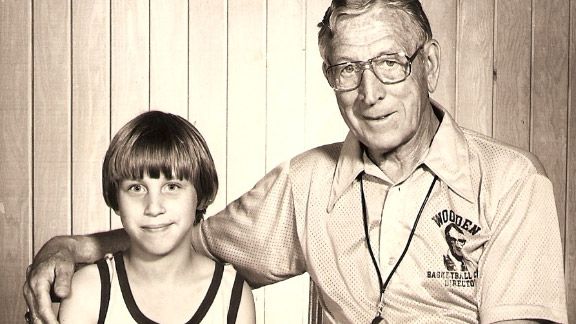
When you think back to being a kid, who were the stars that meant the most to you? They weren’t actually all stars, were they?
The heroes of my youth, the people in sports and culture who affected me, influenced me and changed me … it’s no April Fool’s joke, but no one in their right or wrong mind would have the same group. A mix of legends and larks – some off the wall, some on – all making for good stories.
Some were special for obvious reasons, some only because they arrived in my consciousness at just the right time, just when I needed someone to emulate, or celebrate, or maybe just smile about. They arrived just when I was ready to love them. And I think I do love them. I don’t think I’d be writing about them today if I didn’t love them.
Here is a tribute to some of those who, for different reasons, made a lifelong impression on me as a kid growing up in Los Angeles:
Happy Hairston: In 1972, my final year of living in the first house I knew, the Lakers were having a little bit of a winning streak. For the first time that I can recall, I played basketball with my older brother in the driveway. I was 4 going on 5; he was 8 going on 9. We would pretend to be the Lakers, and he would be Gail Goodrich and tell me that I was Happy Hairston. Even at that young age, I had the sense that I was getting the second-fiddle player – something told me that a basketball player named Happy couldn’t be that good, and might even be a dwarf. But he wasn’t bad, and most importantly, he was my guy. My first sports identity.
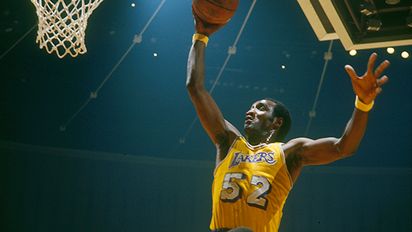 George Long/WireImage/Getty Images
George Long/WireImage/Getty Images* * *
Kent McCord: My earliest “What do you want to be when you grow up” was a policeman. Then, I decided I wanted to be a TV star. Then I saw Adam-12, and I realized I could become both. Even at such a young age, I learned the names of the actors. Kent McCord wins in a tossup over Martin Milner. (It’s funny how times change – my 7 1/2-year-old daughter still hasn’t seen a primetime show because of all the kiddie options available to her, but I was soaking them up on my own TV before my fifth birthday.)
* * *
Hank Aaron: On vacation at the White Stallion Ranch in Tucson, Arizona, when I wasn’t riding horses, avoiding cactii, wearing a bolo tie (John Wooden got it from me) and getting covered in dust, I was chalking up the earliest baseball memory that sticks with me to this day: being in front of a TV set with a bunch of other dude ranchers when Henry Louis Aaron hit his 715th home run. I don’t remember it well – it’s more of a still frame shot in my mind – and deep down, I fear my sister will read this and tell me I’ve got the details all wrong, but all I know is I’ve been seeing that scene in my memory forever. (Below is Vin Scully’s marvelous call.)
* * *
Dr. George Fischbeck: Lots of different things work into this one. At the end of a field trip to a museum early in grade school, I came home with a book, “The World of Weather and Climate.” Around the same time, I started going beyond the comic section of the newspaper and into the weather page. And then there was night after night of watching Channel 7 Eyewitness News on our 5-inch black-and-white kitchen TV, with Jerry Dunphy, Christine Lund, Fast Eddie Alexander, Stu Nahan … and Dr. George, the Captain Kangaroo of weathermen. My brother, sister and I even wrote a song one December, “We Wish You a Merry Fischbeck.” Not only did he introduce me to barometric pressure, he also hosted Saturday night, pre-prime-time half-hour shows, including one burned into my brain that introduced me to the Hindenberg. Oh, the humidity! TV cop had been replaced in my ambitions. I was going to be a TV weatherman.
* * *
James Harris: I just liked him at first because he was good. He was the quarterback the night I truly became a sports fan – August 9, 1975, a preseason 35-7 slaughter by the Rams over the Cowboys at the Coliseum, where for the first time I was truly captivated by the game in front of me. (And they say exhibitions don’t matter!) That I later learned that Harris was a relative pioneer as a black quarterback only enhanced my childhood passion for him. I even had a brief fascination with Grambling. I went from weather to sports, and almost never left.
 Nate Fine/Getty Images
Nate Fine/Getty Images* * *
Lawrence McCutcheon: Lawrence of Los Angeles. I still have the T-shirt I wore 35 years ago – I even had my 5-year-old son try it on … carefully … a few weeks back. One 1,000-yard season after another. The first great player that I discovered for myself. O.J. Simpson and Franco Harris were more famous, but they weren’t mine. Lawrence was my first Pedro Guerrero – an underappreciated heavy-hitter.
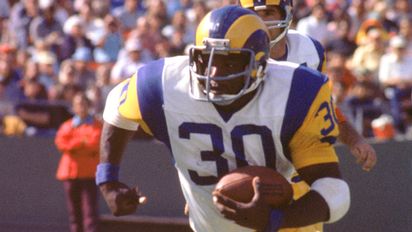 Martin Mills/Getty Images
Martin Mills/Getty Images* * *
Spider Sabich: Later immortalized (if I may use the term ironically) in news and then on “Saturday Night Live” as the skier who was “accidentally shot” by Claudine Longet, Sabich was in a ski film that we watched during our beginner days at June Mountain in the mid-’70s. A race announcer said that Sabich had broken his neck. Then there was a pause. And then, the announcer said – as if he needed time to think about it – that Sabich would be unable to continue racing that day. My brother and I thought that pause was just hysterical. Poor Spider.
* * *
Manny Mota: This one really needs no explanation. Suffice it to say, Mota might have been my first sports folk hero.
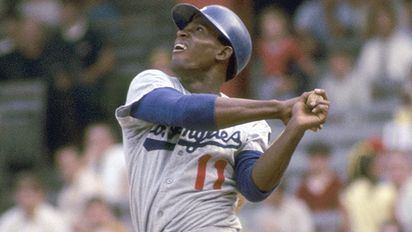 Diamond Images/Getty Images
Diamond Images/Getty Images* * *
Bob Cousy: The sports books I read as a kid had a profound effect on me. I checked a Cousy biography out of the school library, not really knowing anything about him – honestly, I’m not sure I had even heard of him. I might have just checked it out because there was a basketball player on the cover. Reading about the hours and hours of practice he put in as a schoolboy, I got my first introduction to the idea of working at becoming a great athlete – up to that point, I think I assumed sports heroes were born great. For a brief time, I allowed myself to believe that if I worked at it, I could become great – and though that turned out not to be true, I can’t say that ethic has hurt me.
* * *
The Superstars: It was an exhibition … but you couldn’t have told me it didn’t matter. The Superstars on ABC in the mid-’70s were huge to my brother and me. We would watch religiously and stage elaborate recreations. Just thinking of the Obstacle Course makes me sigh … I mean, this was even bigger to me than Battle of the Network Stars.
* * *
Reggie Smith: Garvey, Lopes, Cey and Russell should maybe be on this list, but again, the underappreciated tend to win out for me. And on those 1970s Dodger teams, Smith was underappreciated. I used to think “cool” meant the Fonz and the Sweathogs. Then I realized “cool” meant Reggie Smith. The Yankees could have their Reg-gie, Reg-gie – I liked ours.
 Michael Zagaris/Getty Images
Michael Zagaris/Getty Images* * *
Lynn Swann: In the first Super Bowl I can remember watching live on TV, my life was forever changed by Swann’s tip-to-himself catch of a Terry Bradshaw bomb in a key moment of the Steelers’ victory over the Cowboys. No other football play in my life did I reenact more.
* * *
Ron LeFlore: The roots of this story go to LeVar Burton’s portrayal of LeFlore in “One in a Million: The Ron LeFlore Story,” a TV movie. A baseball player who came … from jail? Rock my world.
* * *
Slick Watts and Curly Neal: For reasons that I can’t explain, if you were a bald basketball player with incredible skills, you had me transfixed.
* * *
Don Chaney: I couldn’t shoot when I first started in grade-school pickup games. My first summer at John Wooden Basketball Camp, when I was 9, my coach actually had me stay in the backcourt while our team was on offense. Thank goodness for the Lakers acquiring Chaney, which introduced to me the concept of the defensive specialist. Now that was something I could aspire to. Now that blocked shot I had at basketball camp on a one-on-one fast break wasn’t just a random event – it was the start of something big. Of course I was fooling myself just as much, but you can still credit most of my understanding that there was more to basketball than scoring to Don Chaney.
* * *
Franz Klammer: “Into the bear turn!” To this day, Klammer winning the gold at Innsbruck is the greatest ski run I’ve ever seen.
* * *
Wes Unseld: One day I decided either I needed a new favorite basketball player, or I wanted to adopt someone who wasn’t a Laker – I forget which, but either way it was just for fun. So I took the boxscores of that morning’s sports section, closed my eyes and stuck a finger down on the name Unseld. I can’t remember the point total next to it, but it probably said 2. And the next day, maybe it said 5. At first, I was disappointed that I had landed on someone who didn’t even score as much as Happy Hairston, but eventually I learned what a great defender and rebounder he was. Wes Unseld was all right in my book.
* * *
Abraham Lincoln: Okay, it’s not exactly profound to include Lincoln, but he makes the list because his geared-for-kids biography was a primary example of the right book making someone larger than life accessible to me. I can’t tell you how many times I re-read that book. It three-dimensionalized him.
* * *
Magic Johnson: Another of my favorite sports stories from kidhood comes from John Wooden Basketball Camp. Each session, Wooden would hold a Q&A with the campers. In the summer of ’79, shortly after the NBA draft, one of the campers asked Wooden which new first-round draft pick would be better for the Lakers: Brad Holland or Earvin Johnson. Wooden avoided the easy choice – Holland, the UCLA graduate – and went out on a limb to choose Magic. And then Magic hugged Kareem, and everyone in Los Angeles had a new best friend.
* * *
Pedro Guerrero: I can remember when Guerrero played second base for the Dodgers. That’s how solid my Guerrero cred is. I can tell you how he batted .625 in his first season. I can explain to you the Bill James argument for why he should have been the 1981 World Series MVP – by himself – and tell you all about the glorious summer of 1985. I will stand no aspersions cast at Pedro Guerrero.
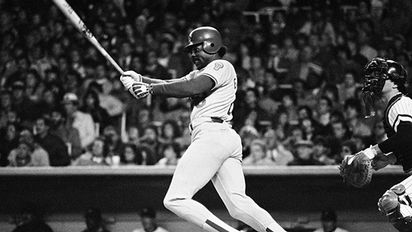 AP
AP* * *
Ken Coleman: The Red Sox announcer wrote a book, “So You Think You Want to Be a Sportscaster.” As it happens, I did think I wanted to be a sportscaster. And I read Coleman’s book inside and out, up, down and sideways, and began trying to broadcast games in my bedroom. And then I turned to writing.
* * *
Steven Bochco: Along with Michael Kozoll, Bochco was the man behind “Hill Street Blues,” the television love of my life. Turned onto it by my brother, I watched it every Thursday, rooting for it to survive its terrible ratings. When my brother went off to college in 1981, I recorded every episode, watched them, then watched them again in late-night marathons with my brother on winter and spring vacations. But strangely, it never occurred to me as a kid to write for television as a grownup, and I think you can blame my overall obsession with sports for that. I spent more time dreaming of making a leaping catch at the wall or a turnaround three-pointer at the buzzer than writing for the greatest show of my generation.
* * *
R.J. Reynolds: Hmm, I think I’ve said a thing or two about R.J. in the past.
* * *
Vin Scully: Around the time I realized I was never going to be a pro athlete, there was Vinny to give my life purpose. I can’t tell you how lucky I feel that to this day, he exists as a role model, as well as the greatest broadcasting voice I’ll ever know.

